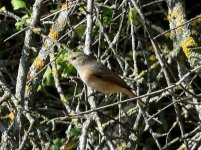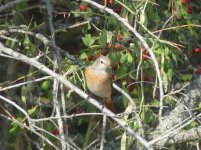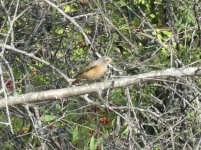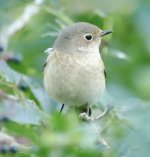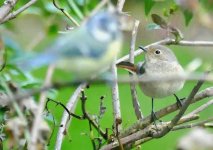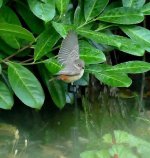-
Welcome to BirdForum, the internet's largest birding community with thousands of members from all over the world. The forums are dedicated to wild birds, birding, binoculars and equipment and all that goes with it.
Please register for an account to take part in the discussions in the forum, post your pictures in the gallery and more.
You are using an out of date browser. It may not display this or other websites correctly.
You should upgrade or use an alternative browser.
You should upgrade or use an alternative browser.
Inmature Redstart? (1 Viewer)
- Thread starter JLRamos
- Start date
More options
Who Replied?It’s certainly a male, age of which I’m unsure however, I’m thinking it might be a 2nd year bird?
Cheers
Why 2nd year and not 1st, Ken?
KenM
Well-known member
I’m not too hot on ageing (personally and avian 🤣) however, I had an all grey bird in the garden early September a few years back and I was assured that it was a 1st year bird (hatch year). This bird looks somewhat more advanced than that Simon?Why 2nd year and not 1st, Ken?
Sounds like juvenile or 1st-year male or adult female black redstart - if so, no useful lessons to be learnt there - their plumage sequences differ.I had an all grey bird in the garden early Sept
KenM
Well-known member
Certainly not a Black Redstart….Sounds like juvenile or 1st-year male or adult female black redstart - if so, no useful lessons to be learnt there - their plumage sequences differ.
Attachments
The bird shown in the OP's photos corresponds quite well with the description and image of a 1st winter male Common Redstart in Collins (Svensson et al).
I don't see many redstarts, but I have seen autumn males with variously obscured head markings and some that are hardly distinguishable to my eye from spring males (at least in the brief glimpses they tend to give). The field guides I have are not particularly consistent on this matter.
I don't see many redstarts, but I have seen autumn males with variously obscured head markings and some that are hardly distinguishable to my eye from spring males (at least in the brief glimpses they tend to give). The field guides I have are not particularly consistent on this matter.
Ah - not 'all grey' at all then.Certainly not a Black Redstart
when male Common Redstarts achieve “full” breeding plumage
KenM
Well-known member
What colour would you call this?Ah - not 'all grey' at all then.
Attachments
Richard Prior
Halfway up an Alp

It’s ‘in the buff’ Ken! Well, underparts are. The upperparts, let’s go for grey/brown ( I wonder if Dulux are still recruiting for paint colour naming executives  ).
).
I’m not too hot on ageing (personally and avian 🤣) however, I had an all grey bird in the garden early September a few years back and I was assured that it was a 1st year bird (hatch year). This bird looks somewhat more advanced than that Simon?
I remembered I have an id paper from Species Files – Guia Blasco Zumeta de Aves
As far as I can see it doesn't mention 2nd year birds after spring, from which I infer they are indistinguishable after the complete postbreeding moult.
OP's bird still looks like a 1cy male to me.
KenM
Well-known member
It’s ‘in the buff’ Ken! Well, underparts are. The upperparts, let’s go for grey/brown ( I wonder if Dulux are still recruiting for paint colour naming executives).
To my eye Richard, the upperpart colour is a concolourous grey, unfortunately it didn’t profile itself for “the camera” but it did to my eyes.It’s ‘in the buff’ Ken! Well, underparts are. The upperparts, let’s go for grey/brown ( I wonder if Dulux are still recruiting for paint colour naming executives).
I never noted any buff to the upperparts when it was less than a metre from the window….try specsavers.😉
Please don't suggest that people have said things that they haven't said. It's bad form and disrespectful.I never noted any buff to the upperparts ….try specsavers
KenM
Well-known member
Depends on the relationship that one has with the recipient….in your case it might be different.😮Please don't suggest that people have said things that they haven't said. It's bad form and disrespectful.
Richard Prior
Halfway up an Alp

So as we have an ‘International special relationship’ I can safely call you a dopey twerp for not reading my post carefully enough Ken : « It’s ‘in the buff’ Ken! Well, underparts are ». To spell it out without my attempted humour, on your bird the underparts look off white with buffish-brown flanks, upperparts grey/brown.
: « It’s ‘in the buff’ Ken! Well, underparts are ». To spell it out without my attempted humour, on your bird the underparts look off white with buffish-brown flanks, upperparts grey/brown.
I think that the OP photos are of a 1st winter male, buffish fringed greater coverts and incomplete supercilium would suggest that.
Have a good Monday All.
I think that the OP photos are of a 1st winter male, buffish fringed greater coverts and incomplete supercilium would suggest that.
Have a good Monday All.
KenM
Well-known member
Richard, my understanding of “in the buff” refers to being naked? (don’t know if our non-English contributors would understand this?)So as we have an ‘International special relationship’ I can safely call you a dopey twerp for not reading my post carefully enough Ken: « It’s ‘in the buff’ Ken! Well, underparts are ». To spell it out without my attempted humour, on your bird the underparts look off white with buffish-brown flanks, upperparts grey/brown.
I think that the OP photos are of a 1st winter male, buffish fringed greater coverts and incomplete supercilium would suggest that.
Have a good Monday All.
I was referring to the bird’s “uppers” not it’s “unders”.
Regarding the ageing of Redstarts!
I can only comment on what I’ve seen.
On a single occasion in Shropshire many years ago, I witnessed, what looked like an immature male Redstart assisting an adult female with the feeding of juveniles that were dispersed amongst the ferns on the ground!
Make of that as you will….left me somewhat perplexed😮
Don’t think they’re double brooded oop North?, so was it a 2nd calendar year unmated bird from the previous year helping out……I don’t know…..and never will.😮
Maybe, in the World-of-Ken, this is how one a) acknowledges that one has publicly misrepresented someone's words and b) apologizes for it.Richard, my understanding of “in the buff” refers to being naked? (don’t know if our non-English contributors would understand this?)
I was referring to the bird’s “uppers” not it’s “unders”.
Take the simplest explanation: that (as is common in black redstart) it was a 1-year-old breeding in immature plumage. No mystery.what looked like an immature male Redstart assisting an adult female with the feeding of juveniles
But... Salop? 'North'?! 🤣 - the view of the UK from London...
Users who are viewing this thread
Total: 2 (members: 0, guests: 2)





